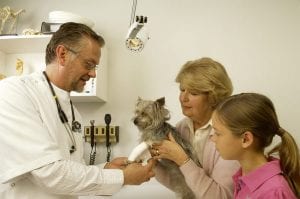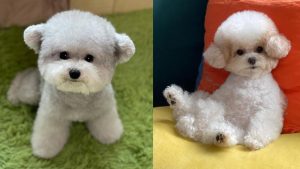If your dog is severely injured, it is, of course, essential to get them to the vet as soon as possible. However, knowing a little first aid yourself will ensure that their cuts have less chance of becoming infected, or of bleeding too much. Whether your puppy has a small scratch or a deep wound, first aid is a vital skill.
Dogs and puppies can get cuts and scratches from all kinds of things: from thorns in the garden, accidents with vehicles or fights with other dogs. No matter what the cause of the cut, it is essential to get to it with some first aid as quickly as possible. Below, we provide you with a four-point guide to treating wounds in dogs and puppies.
1. Muzzle.
Even if your dog is very placid, when they are in pain they may lash out, unable to control how they respond. To avoid any further injury entirely to any humans or animals in the vicinity, it is a good idea to fit a loose muzzle on your dog.
If you do not have a muzzle to hand, you can use a soft rope or something like a necktie or a strip of cloth to gently tie your dog’s mouth shut as you inspect and treat their cut.
Making a homemade muzzle is simple. You need to make a loop, then slip the loop over the dog’s mouth before tightening it and tying it with a knot. The muzzle should be tight enough for your dog to be unable to slip it off, but not so tight that it causes them discomfort.
2. Look for embedded objects and decide whether or not to remove them.
It is totally fine to remove a thorn from your dog’s paw with tweezers. The same goes for other small objects embedded in their paw, such as tiny shards of glass from the pavement.
It is best to remove these small objects early on – otherwise pressing on the wounded area could be unnecessarily painful for them.
Though it may seem counterintuitive, larger objects embedded in your dog’s flesh should not be removed. Removing them can make the blood flow even worse or cause even further internal damage, and so it needs to be done by a veterinarian.
3. Staunch the blood.

If there is any blood, press some sterile gauze firmly on the area (though always making sure not to push on any embedded objects). It is a good idea to have a small first aid kit for your pets ready to hand so that you can grab gauze and other items that you need as quickly as possible.
You may need to use several wads of gauze before the blood flow stops. If the blood flow does not stop after you have applied some gauze onto the affected area with firm pressure for half a minute or so, try applying the gauze for a more extended period.
Take a wad of sterile gauze and place it over the wound. Then, take a sterile bandage or long strip of gauze and use that to wrap around the wounded area and hold the gauze wad in place.
However, if you do want to apply the gauze for a longer time, it is best to do this after you have completed step 4, to ensure that you are securing gauze over a cleaned area.
You can also use human band-aids on doggy wounds. However, your dog will surely lick the band-aid right off unless you place their head in a special collar, like those that are used to stop them from licking their sutures (you know the kind – those collars that are funnel-shaped and look a little like lamp shades).
4. Clean the area.

All that you need for this step is some gentle antibacterial soup, dissolved in warm water.
Using gauze, gently sweep the soapy water over the wound. Do so until all visible particles of mud and dirt are gone. This will also help to get rid of germs that are lurking in your dog’s cut.
You can use the same antibacterial soap that you use on your own hands. Or, you can purchase a specialty brand for dogs. Either will work – what is essential is to flush out the wound with plenty of water and kill harmful germs with a mild antibacterial agent.
If they are not cleaned quickly, cuts can become infected: bacteria multiply very quickly! And, let’s face it – the types of things that dogs tend to cut themselves on are not completely sterile. Thorns, broken glass, other dogs’ teeth, and rusted metal all can harbor some nasty germs.
The final step – head to the vet.
If your dog has a small cut and you have followed all of the steps above you can keep a close eye on their wound at home until it heals. If it takes over a week to recover or starts to emit a foul odor or a discharge (like pus), then take your dog to the vet.
Otherwise, they should be just fine, and running around joyfully again (and hopefully not getting into any more scrapes!) in no time.
If your dog has a larger cut, then you should take them to the vet as a matter of course, once you have completed the steps above. Larger wounds may need to be sutured to help them to heal as quickly as possible. And, if the injury is very large, the vet will need to check that there has been no internal damage that requires surgery.
Doggy first aid is easy when you know how!
So there you have it: now you know exactly what to do if your dog gets a cut. Follow steps one through four and then make an appointment with the vet if, and when, necessary.
That may be as soon as possible or just in a week or so if you are still worried about what seemed a minor cut is not healing correctly.
What should you keep in a canine first aid kit?
Essentials include gauze, antibacterial soap, tweezers – and the number of the vet.





